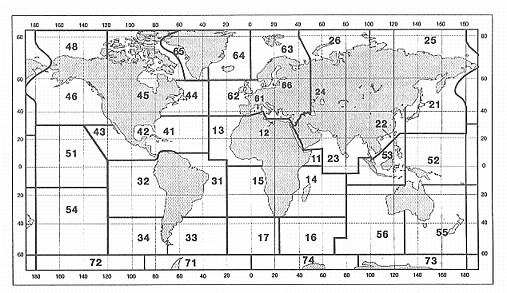YY
MM
J
GGgg
(In BATHY and TESAC, GGgg is the time of launching the bathythermograph.)
Qc
Note: The choice is left to the observer in the following cases:
When the ship is on the Greenwich meridian or the 180th meridian (LoLoLoLo = 0000 or 1800 respectively):
Qc = 1 or 7 (northern hemisphere) or
Qc = 3 or 5 (southern hemisphere);
When the ship is on the Equator (LaLaLa = 000):
Qc = 1 or 3 (eastern longitude) or
Qc = 5 or 7 (western longitude).
LaLaLaLa
LoLoLoLoLo
iu
figure |
||
dd
Code
figure 00 Calm 01 5-14 02 15-24 03 25-34 etc. etc. 36 335-4 99 Variable,
or all directions or unknown or waves confused, direction indetermininate
ff
sn
code figure 0 Positive or zero 1 Negative
TTT
k1
Code figure 7 Values at selected depths (data points fixed by the
instrument or selected by any other method) 8 Values at significant depths
(data points taken from traces at significant depths)
k2
Code figure 0 No salinity measured 1 In situ sensor, accuracy better than 0.02 per mill 2 In situ sensor, accuracy less than 0.02 per mill 3 Sample analysis
z0z0z0z0
z1z1z1z1
znznznzn
z1z1z1z1
znznznzn
T0T0T0T0
T1T1T1T1
TnTnTnTn
T1T1T1T1
TnTnTnTn
For negative temperatures, 5000 shall be added to the absolute value of the temperature in hundredths of a degree Celsius.
S0S0S0S0
S1S1S1S1
SnSnSnSn
S1S1S1S1
SnSnSnSn
00000
k6
figure |
||
k4
Code figure 1 1 hour or less 2 More than 1 hour but 2 at the most 3 More than 2 hours but 4 at the most 4 More than 4 hours but 8 at the most 5 More than 8 hours but 12 at the most 6 More than 12 hours but 18 at the most 7 More than 18 hours but 24 at the most 9 Drift method not used
k3
figure |
||
d0d0
d1d1
dndn
d1d1
dndn
Code figure 00 Calm 01 5-14 02 15-24 03 25-34 etc. etc. 36 335-4 99 Variable, or all directions or unknown or waves confused, direction indetermininate
c0c0c0
c1c1c1
cncncn
c1c1c1
cncncn
ZdZdZdZd
k5
Code figure 2 GEK (Geomagnetic ElectroKinetograph) 3 Ship's set and drift determined by fixes 3-6 hours apart 4 Ship's set and drift determined by fixes more than 6 hours but less than 12 hours apart
DcDc
VcVc
D.....D
A1
bw
